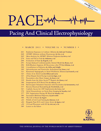Antiarrhythmic Effect of Reverse Electrical Remodeling Associated with Cardiac Resynchronization Therapy
Disclosures: This study was partially supported by Medtronic, Inc. as an Investigator-initiated Research Project (awarded to Drs. Berger and Tereshchenko). Other co-authors have nothing to disclose. Registration identification number NCT00916435.
Abstract
Background: Antiarrhythmic and proarrhythmic effects of cardiac resynchronization therapy (CRT) remain controversial. We hypothesized that reverse electrical remodeling (RER) with CRT is associated with reduced frequency of ventricular tachyarrhythmias (VTs).
Methods: The width of native and paced QRS was measured in lead II electrocardiogram before and 13 ± 7 months after implantation of a CRT defibrillator device in 69 patients (mean age 66.3 ± 13.9; 39 males [83%]) with bundle branch block (BBB) (41 patients with left BBB and three patients with bifascicular block) or nonspecific intraventricular conduction delay (25 patients, 36%), and New York Heart Association class III–IV heart failure. Biventricular pacing was inhibited for 10 seconds to record native QRS. RER was defined as a decrease in the native QRS duration ≥10 ms compared to preimplant. Patients were followed prospectively 24 ± 13 months after assessment for electrical remodeling.
Results: RER was observed in 22 patients (32%), among whom QRS duration decreased by 30.9 ± 14.1 ms (P < 0.00001) with similar heart rate and QRS morphology. Native QRS duration increased by 10.3 ± 16.6 ms in the other 47 patients (68%) (P = 0.0001). Baseline mean ejection fraction did not differ between patients with and those without RER (24.9 ± 10.0 vs 24.2 ± 8.6%, NS). During 2 ± 1 years of further follow-up, 19 patients had VTs and 12 patients died. RER was associated with a fourfold decrease in the risk of death or sustained VTs requiring appropriate implantable cardioverter-defibrillator therapies, whichever came first (hazard ratio 0.25; 95% confidence interval 0.08–0.85; P = 0.026).
Conclusion: RER of the native conduction with CRT is associated with decreased mortality and antiarrhythmic effect of CRT. (PACE 2011; 34:357–364)




